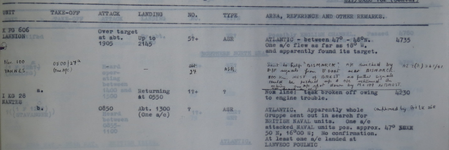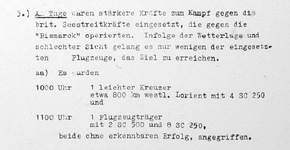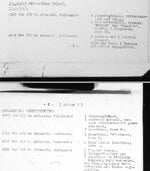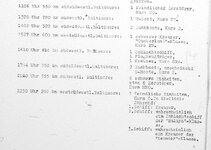Britain did maintain a submarine watch on Brest throughout this part of the war. But each submarine was allocated a large box in which to operate to prevent blue on blue. So don't think of it as a solid line of subs.One does wonder if a few Btitish submarines were lurking about considering what they did to the Kriegsmarine off Norway the year before.
Navigation
Install the app
How to install the app on iOS
Follow along with the video below to see how to install our site as a web app on your home screen.
Note: This feature may not be available in some browsers.
More options
You are using an out of date browser. It may not display this or other websites correctly.
You should upgrade or use an alternative browser.
You should upgrade or use an alternative browser.
Could the Luftwaffe covered Bismarck?
- Thread starter Admiral Beez
- Start date
Ad: This forum contains affiliate links to products on Amazon and eBay. More information in Terms and rules
More options
Who Replied?Andrew Arthy
Airman 1st Class
Hi,
Here are some Luftwaffe operations for 27 May 1941 in support of the Bismarck, the source being the British Y-Service listening in to Luftwaffe radio transmissions:

And from the Luftwaffe daily summary for 27 May 1941:

Rough translation: "During the day, stronger forces were deployed to fight the British naval forces operating against the 'Bismarck'. Due to the weather conditions and poor visibility, only a few of the aircraft deployed managed to reach the target."
And a few Luftwaffe reconnaissance reports from 27 May 1941, showing they saw plenty of British vessels, and carried out some unsuccessful attacks.


Last but not least, a very good summary of the 27 May 1941 efforts by the Luftwaffe, from the war diary of the German Seekriegsleitung (pardon the rough translation):
"Aerial reconnaissance begins according to the orders of the Reichsmarschall [Göring] with all available reconnaissance and combat forces of Fliegerführer Atlantik and Luftflotte 3 for reconnaissance between 46° and 4830 N and the sector north-west of Brest. Start of reconnaissance 04:30, combat units from 06:30, so that around 09:00 in the area of Bismarck. In the course of 27 May 1941, in addition to KG 40 and K.Fl Gr. 406, the combat units of K.Gr. 606, I./KG.28 and K.Gr. 100, which are ready for action, are deployed. Deployment in three waves under unfavourable weather conditions to the limit of combat and reconnaissance range. Due to bad weather conditions, the decisive first wave largely passed 'Bismarck' and the enemy. Few aircraft made contact with the enemy and attacked cruisers and destroyers, but obviously without scoring any hits. Therefore no influence on the battle situation despite full engagement."
Cheers,
Andrew A.
Here are some Luftwaffe operations for 27 May 1941 in support of the Bismarck, the source being the British Y-Service listening in to Luftwaffe radio transmissions:

And from the Luftwaffe daily summary for 27 May 1941:

Rough translation: "During the day, stronger forces were deployed to fight the British naval forces operating against the 'Bismarck'. Due to the weather conditions and poor visibility, only a few of the aircraft deployed managed to reach the target."
And a few Luftwaffe reconnaissance reports from 27 May 1941, showing they saw plenty of British vessels, and carried out some unsuccessful attacks.


Last but not least, a very good summary of the 27 May 1941 efforts by the Luftwaffe, from the war diary of the German Seekriegsleitung (pardon the rough translation):
"Aerial reconnaissance begins according to the orders of the Reichsmarschall [Göring] with all available reconnaissance and combat forces of Fliegerführer Atlantik and Luftflotte 3 for reconnaissance between 46° and 4830 N and the sector north-west of Brest. Start of reconnaissance 04:30, combat units from 06:30, so that around 09:00 in the area of Bismarck. In the course of 27 May 1941, in addition to KG 40 and K.Fl Gr. 406, the combat units of K.Gr. 606, I./KG.28 and K.Gr. 100, which are ready for action, are deployed. Deployment in three waves under unfavourable weather conditions to the limit of combat and reconnaissance range. Due to bad weather conditions, the decisive first wave largely passed 'Bismarck' and the enemy. Few aircraft made contact with the enemy and attacked cruisers and destroyers, but obviously without scoring any hits. Therefore no influence on the battle situation despite full engagement."
Cheers,
Andrew A.
Last edited:
- Thread starter
- #43
Admiral Beez
Major
If this painting of Ark Royal launching her strike on Bismarck is accurate, the weather was truly abysmal.My first thought would be a Sunderland, but considering the weather at the time, it seems that both Coastal Command and the Luftwaffe were grounded.
The Stringbag was a slow torpedo bomber, but a B5N or TBD may find the North Atlantic in spring to be too much. Check out the Illustrious class at 0:31.
Just remembered.
On 27th May after the sinking of the Bismarck, the Tribal class destroyers Tartar and Mashona, which had been escorting Rodney, were detached from the Home Fleet and sent home at economical speed to refuel. On 28th they came under "sustained and heavy air attacks" during which Mashona was bombed in a boiler room and capsized when flooding could not be prevented. She was later sunk by friendly forces off Ireland.
So the Luftwaffe did achieve some success but I have no idea what units or aircraft achieved this sinking.
 uboat.net
uboat.net
On 27th May after the sinking of the Bismarck, the Tribal class destroyers Tartar and Mashona, which had been escorting Rodney, were detached from the Home Fleet and sent home at economical speed to refuel. On 28th they came under "sustained and heavy air attacks" during which Mashona was bombed in a boiler room and capsized when flooding could not be prevented. She was later sunk by friendly forces off Ireland.
So the Luftwaffe did achieve some success but I have no idea what units or aircraft achieved this sinking.
HMS Mashona (F 59) of the Royal Navy - British Destroyer of the Tribal class - Allied Warships of WWII - uboat.net
The U-boat War in World War Two (Kriegsmarine, 1939-1945) and World War One (Kaiserliche Marine, 1914-1918) and the Allied efforts to counter the threat. This section includes over 21.000 Allied Warships and over 11.000 Allied Commanders of WWII, from the US Navy, Royal Navy, Royal Canadian...
Geoffrey Sinclair
Staff Sergeant
- 1,104
- Sep 30, 2021
From Pursuit by Ludovic Kennedy (he was on one of the RN destroyers).
Times are by RN clocks, which I believe were on GMT plus 2 hours summer time starting on 4 May. Dawn on the 27th was around 5 am.
Evading the torpedo attack from Victorious caused the damaged boiler room to completely flood, after doing repairs Bismarck's speed was 20 knots.
The first Catalina sighting report position was 49° 33' N Longitude: -21° 47' W, out by about 25 miles, the correct position was around 690 miles from Brest and Force H was nearer to Brest. Sighting report timed at 10.30, the Swordfish search had been launched at 9 am, Ark Royal reducing speed to 10 knots and turning north west to do so, at 10.50 a Swordfish made a sighting, followed by another Swordfish at 10.57. Ark Royal was then around 50 miles from Bismarck doing 25 knots to make up for lost ground, while "at times the ship seemed almost out of control". The fight deck was 62 feet above the waterline and was occasionally taking it green. Two officers with sextants measured the rise and fall of the stern as 53 and 56 feet. During the approach before locating Bismarck Force H had gone down to 17 knots, wind speed over the deck 50 miles per hour.
All three Catalinas that sighted Bismarck that day had USN personnel on board.
Bismarck was at 167 degrees range 38 miles when the second strike launched. Ark Royal was flying air search and shadowing as well as strike missions, using Swordfish fitted with long range tanks. The second strike force was 15 aircraft and began taking off at 7.10 pm, was briefed to use Sheffield as a guide, found the ship at 8.00 pm but then lost it for the next 35 minutes, found it again and were then given distance and bearing to Bismarck, which was steaming under a weather front, while climbing to 9,000 feet one sub flight found ice forming on their wings. The front effectively stopped any attempt at a co-ordinated strike and it was not until 8.53pm the attack began and appears to have continued until around 9.30 pm. Sunset around 11 pm.
Sheffield was 12 miles astern and could see the AA armament firing. Bismark was around 48 north, maybe 16 or so east. There were Swordfish still in the air shadowing Bismarck all through the attack.
The 10 hours from the 10.30 sighting report at 20 knots to the time of the second strike would have cut the distance to France by around 200 statute miles.
The strike force landing took an hour with 3 crashed and written off, though at least one of these was due to flak damage. (None of the first strike that mainly attacked Sheffield was lost.) Timing was everything, one of the 8 Swordfish recalled from the initial air search to become part of the first strike met the stern coming up rather than the other way around, the crew was unhurt, the aircraft pieces were swept over the side.
Bismarck Wreck location Latitude 48° 6' 0" N Longitude: -16° 11' 60" W or about 500 miles from Brest and even further from Plymouth.
Ark Royal and Renown passed either side of U-556, steering straight courses, time not given but it seems after launching the second strike. If the submarine had any torpedoes left it could have done one of the more spectacular attacks of WWII.
The advantage for the Germans was U-556 corrected Bismarck's position, Bismarck was reporting a position 80 miles in error, but U-556 did not find out and make the signal until several hours after Bismarck had been crippled, no earlier than 23.30 that day. The U-boat could not keep up with Bismarck, it met with U-74 and handed over shadowing duties, when U-556 reached Lorient it had 80 litres of fuel.
The 2 destroyers with the battleships had left before the shooting had stopped, as had at least 1 of the flotilla of 5 destroyers harassing the Bismarck during the night, the battleships left before Bismarck sank but did see it go down. The British knew Bismarck had been transmitting homing signals, so they did not think they could linger for very long. Only the cruiser Dorsetshire and the destroyer Maori were able to pick up survivors. Ark Royal sighted 3 German aircraft, one of which dropped a stick of bombs nearby. The weather was clearing on the day Bismarck was sunk, sighting was made at 25,000 yards.
U-74 sighting a cruiser and 2 destroyers that morning, it had salt water in its batteries, it could not dive after rescuing the 3 Bismark sailors later that day. In fact damage it took earlier in its voyage meant it could not attack. All it could do was shadow. It picked up the three men at 7 pm that night. A German weather ship found 2 more men.
Luftflotte 3, serviceable longer range types but as of 30 June 1941. Ark Royal did have fighters.
II/KG2 23 Do217
I/KG4 19 He111
III/KG4 15 He111
I/KG40 4 Fw200
II/KG40 5 Do217
II/KG40 5 He111
III/KG40 14 He111
KG100 14 He111
KG606 13 Ju88
Kufl 106 4 Ju88
Kufl 106 5 He115
1. Aufl 123 6 Ju88
3. Aufl 123 4 Ju88
Ensign Leonard Smith was part of a group of USN Catalina pilots sent to England on 4th May, after a few days in London 9 of them were sent to 209 and 240 Squadrons, the British promptly sent 9 co-pilots on leave thereby making the Americans the new co-pilots. The Americans had more time on the newly arrived Catalinas than the British.
Smith was assigned to aircraft Z of 209 squadron, commanded by Flying Officer Briggs, they were the first to sight Bismarck and were shot at when they misjudged their approach, later repairing the flak damage with rubber plugs and margarine.
Aircraft M from 240 squadron, had an American copilot, Lieutenant Johnson, it sent a sighting report 1.30 pm. Z/209 closed on the other aircraft but soon departed so as to arrive back during daylight, M/240 stayed until 6pm, being shot at when it came too close.
Bismarck was torpedoed around 9pm, shortly after a third Catalina O/240 arrived with another American copilot, Ensign Rinehart, it too was shot at when it came too close.
Edited, correcting sunset from 9 PM GMT to 11 PM by RN clocks, and adding co-pilot information.
Times are by RN clocks, which I believe were on GMT plus 2 hours summer time starting on 4 May. Dawn on the 27th was around 5 am.
Evading the torpedo attack from Victorious caused the damaged boiler room to completely flood, after doing repairs Bismarck's speed was 20 knots.
The first Catalina sighting report position was 49° 33' N Longitude: -21° 47' W, out by about 25 miles, the correct position was around 690 miles from Brest and Force H was nearer to Brest. Sighting report timed at 10.30, the Swordfish search had been launched at 9 am, Ark Royal reducing speed to 10 knots and turning north west to do so, at 10.50 a Swordfish made a sighting, followed by another Swordfish at 10.57. Ark Royal was then around 50 miles from Bismarck doing 25 knots to make up for lost ground, while "at times the ship seemed almost out of control". The fight deck was 62 feet above the waterline and was occasionally taking it green. Two officers with sextants measured the rise and fall of the stern as 53 and 56 feet. During the approach before locating Bismarck Force H had gone down to 17 knots, wind speed over the deck 50 miles per hour.
All three Catalinas that sighted Bismarck that day had USN personnel on board.
Bismarck was at 167 degrees range 38 miles when the second strike launched. Ark Royal was flying air search and shadowing as well as strike missions, using Swordfish fitted with long range tanks. The second strike force was 15 aircraft and began taking off at 7.10 pm, was briefed to use Sheffield as a guide, found the ship at 8.00 pm but then lost it for the next 35 minutes, found it again and were then given distance and bearing to Bismarck, which was steaming under a weather front, while climbing to 9,000 feet one sub flight found ice forming on their wings. The front effectively stopped any attempt at a co-ordinated strike and it was not until 8.53pm the attack began and appears to have continued until around 9.30 pm. Sunset around 11 pm.
Sheffield was 12 miles astern and could see the AA armament firing. Bismark was around 48 north, maybe 16 or so east. There were Swordfish still in the air shadowing Bismarck all through the attack.
The 10 hours from the 10.30 sighting report at 20 knots to the time of the second strike would have cut the distance to France by around 200 statute miles.
The strike force landing took an hour with 3 crashed and written off, though at least one of these was due to flak damage. (None of the first strike that mainly attacked Sheffield was lost.) Timing was everything, one of the 8 Swordfish recalled from the initial air search to become part of the first strike met the stern coming up rather than the other way around, the crew was unhurt, the aircraft pieces were swept over the side.
Bismarck Wreck location Latitude 48° 6' 0" N Longitude: -16° 11' 60" W or about 500 miles from Brest and even further from Plymouth.
Ark Royal and Renown passed either side of U-556, steering straight courses, time not given but it seems after launching the second strike. If the submarine had any torpedoes left it could have done one of the more spectacular attacks of WWII.
The advantage for the Germans was U-556 corrected Bismarck's position, Bismarck was reporting a position 80 miles in error, but U-556 did not find out and make the signal until several hours after Bismarck had been crippled, no earlier than 23.30 that day. The U-boat could not keep up with Bismarck, it met with U-74 and handed over shadowing duties, when U-556 reached Lorient it had 80 litres of fuel.
The 2 destroyers with the battleships had left before the shooting had stopped, as had at least 1 of the flotilla of 5 destroyers harassing the Bismarck during the night, the battleships left before Bismarck sank but did see it go down. The British knew Bismarck had been transmitting homing signals, so they did not think they could linger for very long. Only the cruiser Dorsetshire and the destroyer Maori were able to pick up survivors. Ark Royal sighted 3 German aircraft, one of which dropped a stick of bombs nearby. The weather was clearing on the day Bismarck was sunk, sighting was made at 25,000 yards.
U-74 sighting a cruiser and 2 destroyers that morning, it had salt water in its batteries, it could not dive after rescuing the 3 Bismark sailors later that day. In fact damage it took earlier in its voyage meant it could not attack. All it could do was shadow. It picked up the three men at 7 pm that night. A German weather ship found 2 more men.
Luftflotte 3, serviceable longer range types but as of 30 June 1941. Ark Royal did have fighters.
II/KG2 23 Do217
I/KG4 19 He111
III/KG4 15 He111
I/KG40 4 Fw200
II/KG40 5 Do217
II/KG40 5 He111
III/KG40 14 He111
KG100 14 He111
KG606 13 Ju88
Kufl 106 4 Ju88
Kufl 106 5 He115
1. Aufl 123 6 Ju88
3. Aufl 123 4 Ju88
Ensign Leonard Smith was part of a group of USN Catalina pilots sent to England on 4th May, after a few days in London 9 of them were sent to 209 and 240 Squadrons, the British promptly sent 9 co-pilots on leave thereby making the Americans the new co-pilots. The Americans had more time on the newly arrived Catalinas than the British.
Smith was assigned to aircraft Z of 209 squadron, commanded by Flying Officer Briggs, they were the first to sight Bismarck and were shot at when they misjudged their approach, later repairing the flak damage with rubber plugs and margarine.
Aircraft M from 240 squadron, had an American copilot, Lieutenant Johnson, it sent a sighting report 1.30 pm. Z/209 closed on the other aircraft but soon departed so as to arrive back during daylight, M/240 stayed until 6pm, being shot at when it came too close.
Bismarck was torpedoed around 9pm, shortly after a third Catalina O/240 arrived with another American copilot, Ensign Rinehart, it too was shot at when it came too close.
Edited, correcting sunset from 9 PM GMT to 11 PM by RN clocks, and adding co-pilot information.
Last edited:
special ed
1st Lieutenant
- 6,601
- May 13, 2018
The copilot on at least one Cat was USN as you pointed out. I had not read what duties the other USN members did.
Two thoughts.
Sending German single-seat fighters over open ocean in poor weather would be a likely disaster. No training in over sea flight and navigation. Crossing the Channel was a different mission.
Ark Royal and AA. Its ability to cope with the rate of descent of dive-bombers would have been a weakness. However the weather (cloud ceiling) surely precluded proper dive-bombing tactics.
Sending German single-seat fighters over open ocean in poor weather would be a likely disaster. No training in over sea flight and navigation. Crossing the Channel was a different mission.
Ark Royal and AA. Its ability to cope with the rate of descent of dive-bombers would have been a weakness. However the weather (cloud ceiling) surely precluded proper dive-bombing tactics.
Allan Hunter
Airman
- 49
- Jan 30, 2020
Beauforts from St Eval in Cornwall were briefed to intercept the Bismarck, and the crews knew at the time that they could not make it there and back. High speed launches, they were told at their briefing, would pick them up when they ditched. Fortunately this operation was canceled when the Bismarck was sunk. My source is 'From Coastal Command to Captivity' Pen and Sword publications, 2014My first thought would be a Sunderland, but considering the weather at the time, it seems that both Coastal Command and the Luftwaffe were grounded.
Users who are viewing this thread
Total: 1 (members: 0, guests: 1)
